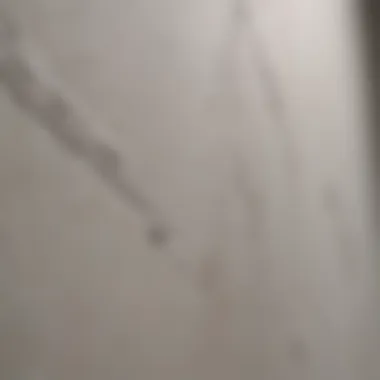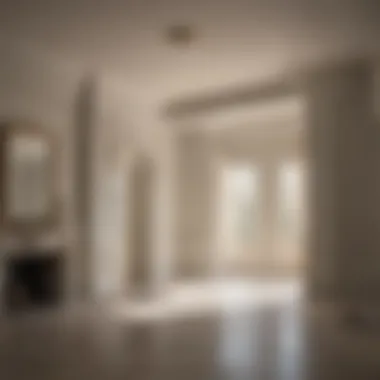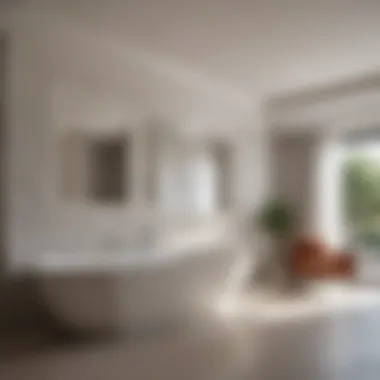Materials:
When embarking on a drywall installation project, it is essential to have all the necessary materials ready to ensure a smooth and efficient process. The following is a detailed list of materials required for this task:
-
Drywall sheets: Ensure you have enough drywall sheets to cover the entire installation area. Measure the dimensions of the walls to determine the quantity needed accurately.
-
Drywall screws: Select high-quality drywall screws that are appropriate in length for securing the drywall sheets in place. Avoid using screws that are too long, as they can damage the drywall.
-
Joint compound: This essential material is used to seal joints between drywall panels and for smoothing out imperfections in the surface. Choose a joint compound suitable for your specific project requirements.
-
Joint tape: Reinforce the joints between drywall sheets using joint tape to prevent cracks from forming over time. Ensure the tape is of good quality for optimal results.
-
Sandpaper: Have different grits of sandpaper on hand to sand down any rough edges or surfaces after the joint compound has dried.
-
Utility knife: A sharp utility knife is indispensable for cutting drywall sheets to size and making precise adjustments during the installation process.
-
T-square: Use a T-square to ensure accurate and straight cuts when trimming drywall sheets to fit corners or edges.
-
Scaffold or ladder: Depending on the height of the installation area, have a scaffold or ladder available to safely reach high sections during the project.
-
Dust mask and goggles: Protect yourself from inhaling dust particles and debris during sanding and cutting activities by wearing a dust mask and goggles.
-
Drywall lift (optional): For ceiling installations or handling large sheets, a drywall lift can greatly ease the process and reduce physical strain.
Having these materials readily available will contribute to a successful drywall installation project while maintaining quality and precision throughout the process.
Introduction
Drywall, often overlooked yet essential in contemporary house construction, serves as a fundamental component that solidifies the very structure of our homes. Its significance lies not only in its practical applications but also in the nuances it adds to the overall aesthetics and functionality of a living space. As we navigate through the complexities of modern construction methods, understanding the role of drywall unveils a realm of possibilities for homeowners seeking durability, customization, and efficiency in their dwellings.
What is Drywall?
Drywall, also known as plasterboard or wallboard, consists of gypsum plaster pressed between two thick sheets of paper. This composite material has revolutionized the construction industry due to its versatility, ease of installation, and cost-effectiveness. Acting as a blank canvas for interior design, drywall paves the way for creativity in shaping living spaces, providing a smooth surface for painting or wallpapering, showcasing individual style and taste.
Historical Evolution of Drywall
The evolution of drywall dates back to the early 20th century when it emerged as a faster, more efficient alternative to traditional lath and plaster construction. Its inception revolutionized building practices, enabling rapid installation, and smoother finishes. Over the years, advancements in materials and manufacturing processes have further enhanced the quality and durability of drywall, making it a staple in modern construction projects across the globe.
Purpose of Drywall in House Construction
Drywall serves multifaceted purposes in house construction, ranging from partitioning rooms and creating interior walls to providing fire resistance and sound insulation. Beyond its structural functions, drywall acts as a canvas for homeowners to express their creativity through various finishes, textures, and decorative treatments. Its seamless integration into interior design allows for a tailored, aesthetically pleasing environment that reflects the individuality and taste of the occupants.
Types of Drywall Materials
Drywall materials play a fundamental role in the construction of modern houses, impacting both the structural integrity and overall aesthetic appeal of a home. Understanding the different types of drywall materials available on the market is crucial for homeowners and builders alike. Each type serves specific purposes and offers distinct advantages.
Standard Drywall
Standard drywall, also known as gypsum board, is the most commonly used type of drywall in residential construction. It is versatile, affordable, and relatively easy to install. Standard drywall is ideal for interior walls and ceilings in dry areas where moisture is not a concern. Homeowners can choose from varying thicknesses to suit their specific needs, with options for fire-resistant and mold-resistant formulations.
Greenboard Drywall
Greenboard drywall, or moisture-resistant drywall, is designed for use in high-humidity areas such as bathrooms, kitchens, and basements. It has a moisture-resistant paper covering that helps prevent mold and mildew growth. Greenboard drywall offers enhanced durability in areas prone to moisture exposure, providing long-lasting protection against water damage.
Blueboard Drywall
Blueboard drywall, often used in plaster veneer construction, has a special blue covering that serves as a base for veneer plastering. It is highly absorbent, allowing plaster to adhere effectively for a smooth finish. Blueboard drywall is dense and durable, making it a preferred choice for applications where a traditional plaster finish is desired.
Soundproof Drywall


Soundproof drywall, also known as acoustic drywall, is engineered to reduce sound transmission between rooms. It incorporates additional layers or special materials that absorb sound waves, reducing noise transfer. Soundproof drywall is beneficial in homes where maintaining acoustical privacy is crucial, such as media rooms, bedrooms, or home offices. Its sound-dampening properties can enhance overall comfort and tranquility within living spaces.
Installation Process of Drywall


In the realm of modern house construction, the installation process of drywall stands as a critical juncture where precision and expertise meet creativity. The key facets within this phase not only dictate the structure's integrity and functionality but also significantly influence the overall aesthetics of the space. As imperative as the choice of drywall material itself, the installation process ensures a seamless transition from bare framework to a structured living environment, primed for personalized touches and style. Embracing the installation process of drywall means embarking on a transformative journey that shapes the very essence of a home's character.
Preparation of Walls


The preparatory stages preceding the installation of drywall merit meticulous attention to detail, laying the groundwork for a flawless outcome. Among these crucial preparatory measures is the removal of old material, an integral step that sets the stage for a fresh canvas of possibilities. This process involves carefully dismantling any existing drywall or finishing materials, safeguarding against potential structural compromise and ensuring a pristine foundation for the new installation. The removal of old material is not merely a functional requirement but a strategic maneuver aimed at fortifying the structural soundness of the space, underscoring the commitment to quality and durability.
Inspection for Structural Soundness
Simultaneously complementing the removal of old material is the comprehensive inspection for structural soundness, an indispensable assessment that guarantees the stability and safety of the impending structure. This meticulous examination entails scrutinizing the framework for any signs of wear, damage, or deviations from architectural standards. By pinpointing and rectifying structural weaknesses in this initial phase, homeowners and contractors alike preempt potential hazards, reinforcing the long-term resilience and functionality of the constructed space. The inspection for structural soundness is not merely a precautionary measure but a proactive initiative aimed at instilling confidence in the reliability and longevity of the architectural endeavor.
Measuring and Cutting Drywall Sheets
The precision required in measuring and cutting drywall sheets underscores the essence of craftsmanship and attention to detail in the installation process. Equipped with the necessary tools – precise tape measures, cutting knives, and straightedges – craftsmen embark on the intricate task of customizing drywall sheets to align seamlessly with the architectural contours of the space. This harmonious integration not only ensures a snug fit and visually pleasing finish but also optimizes the structural stability and acoustic performance of the installed material.
Tools Required
Central to the efficiency and accuracy of the cutting process are the specialized tools specifically designed for this purpose. From reliable stud finders to high-quality utility knives, each tool fulfills a distinct role in achieving precision and consistency in cutting drywall sheets. The strategic selection of tools not only streamlines the installation process but also elevates the overall quality and finesse of the finished product.
Techniques for Precision Cutting
Mastering the art of precision cutting entails employing a variety of techniques tailored to the unique requirements of the project. Whether utilizing score-and-snap methods or advanced rotary cutting tools, craftsmen navigate the intricacies of drywall manipulation with finesse and expertise. These techniques not only differentiate amateurs from seasoned professionals but also determine the quality, efficiency, and visual appeal of the final installation, reflecting a harmonious blend of artistry and functionality.
Attaching Drywall to Walls
The method of attaching drywall to walls, be it through screws or nails, represents a pivotal decision with far-reaching repercussions on the structural integrity and longevity of the construction. The choice between screws and nails extends beyond mere functional considerations, encompassing elements of durability, ease of installation, and future maintenance requirements. By evaluating the specific needs and design intricacies of the project, craftsmen can optimize the attachment process, ensuring a secure and enduring integration of drywall into the architectural framework.
Screwing vs. Nailing
The timeless debate between screwing and nailing hinges on a fundamental choice between enhanced durability and expedited installation. Screws, with their superior grip and load-bearing capacity, offer a reliable solution for environments demanding heightened resilience and longevity. On the other hand, nails provide a quicker and more economical alternative, ideal for projects prioritizing efficiency and temporary fixations. The decision between screwing and nailing encapsulates a nuanced balance between structural robustness, installation speed, and long-term maintenance considerations, laying bare the intricate artistry inherent in the installation process.
Importance of Quality Drywall
In the realm of modern house construction, the significance of quality drywall cannot be overstated. It serves as a fundamental component that not only partitions spaces but also plays a vital role in enhancing the overall structural integrity and aesthetics of a dwelling. The careful selection and installation of premium-grade drywall can vastly influence the functionality and visual appeal of a home, making it a critical consideration for homeowners, architects, and interior designers alike.
Enhancing Structural Integrity
When discussing the importance of quality drywall, one cannot ignore its substantial impact on the structural robustness of a building. High-quality drywall acts as a protective barrier, shielding the interior structure from external elements and impacts. By providing a stable surface for paint, tiles, or wallpapers, quality drywall contributes to the longevity and durability of the construction. Moreover, its soundproofing properties can significantly reduce noise transmission between rooms, fostering a peaceful and comfortable living environment.
Aesthetics and Design Considerations
Beyond its structural function, quality drywall also plays a pivotal role in the aesthetics and design of a modern home. Smooth, flawless drywall surfaces form a canvas for various decorative finishes, adding a touch of elegance and sophistication to interior spaces. Properly installed and finished drywall can create seamless transitions between walls and ceilings, enhancing the visual flow and uniformity of a room. Additionally, the versatility of drywall allows for creative design possibilities, such as recessed lighting, built-in shelves, or intricate moulding details, elevating the overall appeal of the living space.
Impact on Insulation and Energy Efficiency
Quality drywall contributes significantly to the insulation and energy efficiency of a house. By forming airtight seals and barriers, drywall helps regulate indoor temperatures, reducing the energy consumption required for heating and cooling. Proper insulation provided by quality drywall also prevents heat loss or gain through walls, promoting a more sustainable and environmentally-friendly living environment. Additionally, quality drywall materials with enhanced thermal properties can further improve the overall energy efficiency of a home, thus reducing utility costs and minimizing environmental impact.
Maintenance and Repair of Drywall
Maintenance and repair of drywall hold significant importance in the realm of modern house construction. Ensuring the upkeep and rectification of drywall issues is crucial for preserving the structural integrity and aesthetics of a home. By promptly addressing maintenance needs and executing effective repair techniques, homeowners can prolong the lifespan of their drywall and maintain the visual appeal of their living spaces.
Common Drywall Issues
Cracks and Holes
Cracks and holes in drywall are common occurrences that can mar the appearance of walls and ceilings. These imperfections stem from various factors such as settling of the building, temperature fluctuations, or poor installation practices. While cracks may seem superficial, they can indicate underlying structural problems and compromise the stability of the drywall. Homeowners should address cracks and holes promptly to prevent further damage and maintain the smooth surface of the walls.
Water Damage
Water damage poses a significant threat to drywall, leading to stains, warping, and mold growth. Whether from leaking pipes, roof leaks, or flooding, water infiltration can severely weaken drywall, compromising its structural integrity. Addressing water damage promptly is imperative to prevent mold infestation, wood rot, and further deterioration of the drywall. Proper remediation techniques and moisture control measures can mitigate the impact of water damage on drywall surfaces.
Repair Techniques
Patch and Fill Methods
Patch and fill methods are essential repair techniques used to restore the seamless finish of damaged drywall. Whether dealing with cracks, holes, or dents, patching involves filling the damaged area with joint compound or spackling paste, smoothing it out, and sanding it for a flush surface. By employing precise patching methods, homeowners can effectively conceal imperfections and maintain the aesthetic appeal of their walls.
Repainting Tips
Repainting is a common practice following drywall repairs or to refresh the look of a room. Proper preparation, choice of paint, and application techniques are key to achieving a professional-grade finish. Before repainting, ensure thorough cleaning of the surface, application of primer for adhesion, and selection of high-quality paint for durability. Additionally, employing the right tools and methods, such as using rollers for even coverage and avoiding drips, can enhance the longevity and visual appeal of the repainted drywall.
Conclusion
In the realm of modern house construction, the importance of drywall cannot be overstated. It serves as a foundational element that not only adds finesse to interiors but also plays a crucial role in structural integrity and energy efficiency. One of the key aspects highlighting the significance of drywall is its ability to provide a smooth and uniform surface for painting and decoration. This contributes significantly to the overall aesthetics of a home, providing a clean canvas for homeowners to express their style and taste. Moreover, from a practical standpoint, quality drywall enhances sound insulation and fire resistance, fostering a safe and serene living environment.
Another vital consideration is the impact of quality drywall on energy efficiency. Properly installed and well-maintained drywall can act as a thermal barrier, preventing heat loss during winters and heat gain during summers. This not only reduces energy costs but also lessens the overall carbon footprint of a household. Therefore, the choice of quality drywall materials and proper installation techniques is paramount in optimizing energy conservation within a home. Overall, the importance of quality drywall in modern house construction transcends mere aesthetics, encompassing structural stability, energy efficiency, and comfort for homeowners.
Summary of Key Points
- Drywall is crucial for both aesthetic appeal and structural integrity in modern house construction.
- Quality drywall provides a smooth surface for painting and decoration, enhancing the overall look of a home.
- Properly installed drywall contributes to sound insulation and fire resistance, ensuring a safe living environment.
- Quality drywall plays a significant role in energy efficiency by acting as a thermal barrier to regulate indoor temperatures.
Future Trends in Drywall Innovation
As technology continues to advance, the field of drywall innovation is not exempt from progression. Future trends in drywall are anticipated to focus on sustainability, enhanced performance, and ease of installation. Manufacturers are increasingly exploring eco-friendly materials and processes that minimize environmental impact without compromising quality. Moreover, there is a growing emphasis on smart drywall solutions that integrate technology for improved energy efficiency and functionality.
Innovations such as mold-resistant drywall, self-healing drywall compounds, and interactive wall panels are reshaping the landscape of drywall construction. These developments not only offer practical benefits, such as enhanced durability and ease of maintenance but also open up creative possibilities for personalized home design. Furthermore, advancements in acoustic drywall technology aim to further optimize sound insulation properties, catering to the demand for quiet and peaceful living spaces.
With a shift towards sustainability, efficiency, and customization, the future of drywall innovation holds promise for revolutionizing the way we approach interior construction. By staying abreast of these emerging trends and embracing novel solutions, homeowners can look forward to homes that are not only aesthetically pleasing but also sustainable and technologically advanced.





